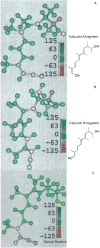Optical signatures of molecular dissymmetry: combining theory with experiments to address stereochemical puzzles
- PMID: 19378940
- PMCID: PMC2704476
- DOI: 10.1021/ar8002859
Optical signatures of molecular dissymmetry: combining theory with experiments to address stereochemical puzzles
Abstract
Modern chemistry emerged from the quest to describe the three-dimensional structure of molecules: van't Hoff's tetravalent carbon placed symmetry and dissymmetry at the heart of chemistry. In this Account, we explore how modern theory, synthesis, and spectroscopy can be used in concert to elucidate the symmetry and dissymmetry of molecules and their assemblies. Chiroptical spectroscopy, including optical rotatory dispersion (ORD), electronic circular dichroism (ECD), vibrational circular dichroism (VCD), and Raman optical activity (ROA), measures the response of dissymmetric structures to electromagnetic radiation. This response can in turn reveal the arrangement of atoms in space, but deciphering the molecular information encoded in chiroptical spectra requires an effective theoretical approach. Although important correlations between ECD and molecular stereochemistry have existed for some time, a battery of accurate new theoretical methods that link a much wider range of chiroptical spectroscopies to structure have emerged over the past decade. The promise of this field is considerable: theory and spectroscopy can assist in assigning the relative and absolute configurations of complex products, revealing the structure of noncovalent aggregates, defining metrics for molecular diversity based on polarization response, and designing chirally imprinted nanomaterials. The physical organic chemistry of chirality is fascinating in its own right: defining atomic and group contributions to optical rotation (OR) is now possible. Although the common expectation is that chiroptical response is determined solely by a chiral solute's electronic structure in a given environment, chiral imprinting effects on the surrounding medium and molecular assembly can, in fact, dominate the chiroptical signatures. The theoretical interpretation of chiroptical markers is challenging because the optical properties are subtle, resulting from the strong electric dipole and the weaker electric quadrupole and magnetic dipole perturbations by the electromagnetic field. Moreover, OR arises from a combination of nearly canceling contributions to the electronic response. Indeed, the challenge posed by the chiroptical properties delayed the advent of even qualitatively accurate descriptions for some chiroptical signatures until the past decade when, for example, prediction of the observed sign of experimental OR became accessible to theory. The computation of chiroptical signatures, in close coordination with synthesis and spectroscopy, provides a powerful framework to diagnose and interpret the dissymmetry of chemical structures and molecular assemblies. Chiroptical theory now produces new schemes to elucidate structure, to describe the specific molecular sources of chiroptical signatures, and to assist in our understanding of how dissymmetry is templated and propagated in the condensed phase.
Figures









Similar articles
-
Determining the absolute configuration of two marine compounds using vibrational chiroptical spectroscopy.J Org Chem. 2012 Jan 20;77(2):858-69. doi: 10.1021/jo201598x. Epub 2012 Jan 3. J Org Chem. 2012. PMID: 22148737
-
Absolute configuration of an axially chiral sulfonate determined from its optical rotatory dispersion, electronic circular dichroism, and vibrational circular dichroism spectra.Chirality. 2017 Nov;29(11):670-676. doi: 10.1002/chir.22739. Epub 2017 Aug 18. Chirality. 2017. PMID: 28833487
-
Stereochemistry of the tadalafil diastereoisomers: a critical assessment of vibrational circular dichroism, electronic circular dichroism, and optical rotatory dispersion.J Med Chem. 2013 Nov 14;56(21):8903-14. doi: 10.1021/jm401407w. Epub 2013 Nov 5. J Med Chem. 2013. PMID: 24116968
-
Time-dependent density functional response theory for electronic chiroptical properties of chiral molecules.Top Curr Chem. 2011;298:1-98. doi: 10.1007/128_2010_72. Top Curr Chem. 2011. PMID: 21321799 Review.
-
Recent Trends in Chiroptical Spectroscopy: Theory and Applications of Vibrational Circular Dichroism and Raman Optical Activity.Chempluschem. 2020 Mar;85(3):561-575. doi: 10.1002/cplu.202000014. Epub 2020 Mar 18. Chempluschem. 2020. PMID: 32187832 Review.
Cited by
-
Probing chirality fluctuations in molecules by nonlinear optical spectroscopy.J Chem Phys. 2014 Dec 21;141(23):234305. doi: 10.1063/1.4903858. J Chem Phys. 2014. PMID: 25527933 Free PMC article.
-
VCD studies on chiral characters of metal complex oligomers.Int J Mol Sci. 2013 Jan 7;14(1):964-78. doi: 10.3390/ijms14010964. Int J Mol Sci. 2013. PMID: 23296273 Free PMC article. Review.
-
Novel coherent two-dimensional optical spectroscopy probes of chirality exchange and fluctuations in molecules.J Chem Phys. 2011 Nov 21;135(19):194201. doi: 10.1063/1.3658277. J Chem Phys. 2011. PMID: 22112074 Free PMC article.
-
A Chirality-Based Quantum Leap.ACS Nano. 2022 Apr 26;16(4):4989-5035. doi: 10.1021/acsnano.1c01347. Epub 2022 Mar 23. ACS Nano. 2022. PMID: 35318848 Free PMC article. Review.
References
-
- Kauzmann W. Quantum chemistry: An introduction. Academic Press; New York: 1957.
-
- Polavarapu PL. Ab initio molecular optical rotations and absolute configurations. Mol Phys. 1997;91:551–554.
-
- Kondru RK, Wipf P, Beratan DN. Theory-assisted determination of absolute stereochemistry for complex natural products via computation of molar rotation angles. J Am Chem Soc. 1998;120:2204–2205.
-
- Crawford TD. Ab initio calculation of molecular chiroptical properties. Theor Chem Acc. 2006;115:227–245.
-
- Autschbach J. Computation of optical rotation using time-dependent density functional theory. Comp Lett. 2007;3:131–150.
Publication types
MeSH terms
Substances
Grants and funding
LinkOut - more resources
Full Text Sources
Miscellaneous

